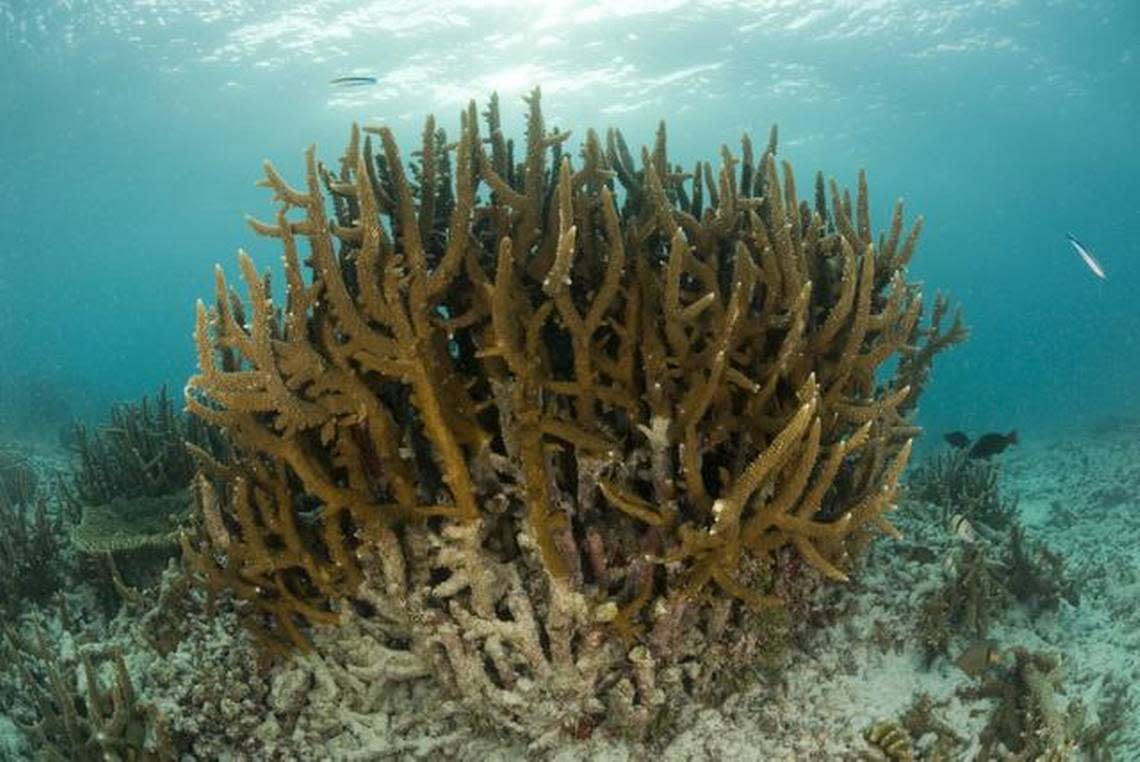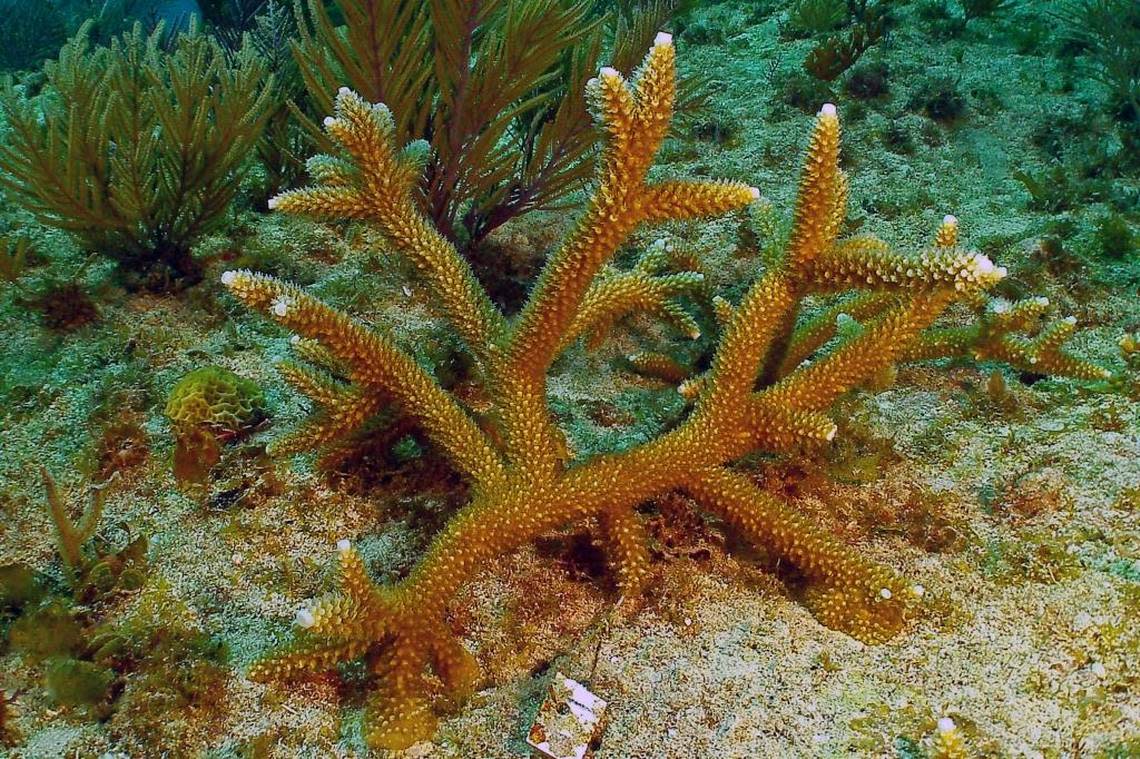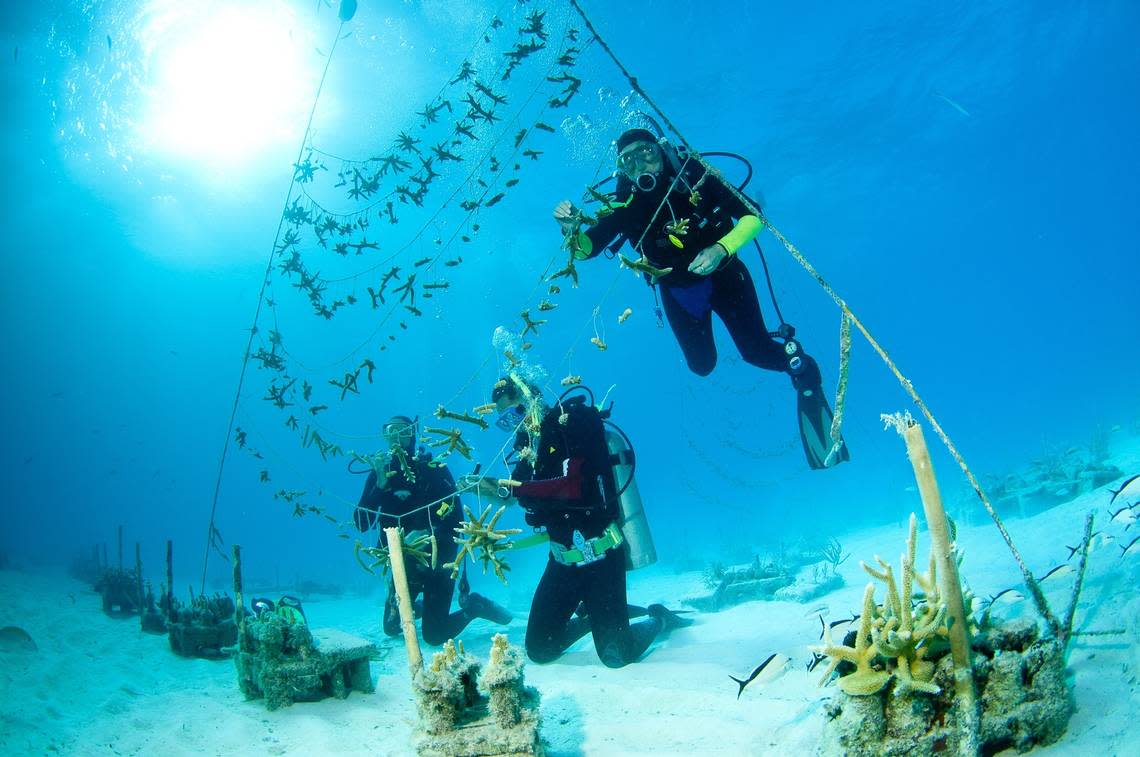‘Massive’ coral bleaching event hits Florida. It’s not a good sign for struggling reefs
Dalton Hesley led a dive team to an offshore Miami Beach reef last month in pursuit of sea urchins. Something else drew his attention instead. A cluster of staghorn corals, their branches reaching toward the surface, appeared a ghastly white.
Hesley, a senior research associate at the University of Miami Rosenstiel School’s Benthic Ecology and Coral Restoration Lab, was immediately concerned. He had visited the same site one week before and found the corals a normal healthy orange-brown. In just seven days, these staghorn — some wild, some replanted in efforts to restore the once common species — had experienced a phenomenon called coral bleaching.
It’s not a good sign for corals and, unfortunately, was not an isolated event.
Florida reefs are experiencing the “first widespread, mass bleaching event” in seven years, said Derek Manzello, coordinator of the National Oceanic and Atmospheric Administration’s Coral Reef Watch.
“There is a confirmed, widespread bleaching event taking place from the Dry Tortugas in the Florida Keys, all the way up to Martin County,” he said. “This is at least the eighth mass bleaching event that has impacted the entire Florida Keys since 1987.”
Read More: Scientists want to rescue reefs and protect Miami with tougher breeds of staghorn coral
Coral bleaching hasn’t just been a persistent problem on the Florida reef tract. It’s occurred in the Caribbean and Pacific as well and scientists have linked it most directly to rising ocean temperatures driven by climate change.

Bleaching is a clear sign corals are under stress, but it’s not always permanent or fatal — though it can be if it persists over long periods. Scientists believe the warming waters trigger the coral to expel algae that normally lives within their tissues. The algae provides coral with its color and serves as its primary food source, but can turn toxic at high temperatures. So corals push it out, turn a sickly pale and risk starvation.
Blossomed, then paled
At a second site in Miami Beach, Hesley found similar symptoms. Wild and restored staghorns, wild star corals and brain corals had begun to pale or had bleached entirely.
“These corals that have really blossomed right in front of our eyes over the last year are now on the brink,” Hesley said. “They’re as stressed as these corals can possibly be.”
Different species of coral have different susceptibilities to bleaching, Hesley said. Staghorns are “moderate” in their sensitivity to bleaching, meaning they are a strong indicator of when other species are suffering.
“That was when it became really apparent that this was a more significant bleaching event than a few individual colonies,” Hesley said.

So far, Hesley said the severe bleaching within the county seems specific to Miami Beach. The Florida Fish and Wildlife Conservation Commission organized a disturbance response monitoring dive to check other areas for signs of disease, hurricane damage or bleaching. Neither Sunny Isles, Key Biscayne nor Biscayne National Park had similar levels of coral damage.
Still, the rest of Miami-Dade is not out of the hot seat.
The Florida Department of Environmental Protection’s BleachWatch program released a current condition report last month to assess the health of Florida’s reefs. The report stated that temperature stress is “increasing at the fastest rate in Miami-Dade County.” Out of 22 reports in the last month describing corals with signs of paling or bleaching across Southeast Florida, 10 came from Miami-Dade.
“Bleaching events are getting more frequent and more severe,” Coral Reef Watch coordinator Manzello said, “both in Florida and worldwide.”
Coral loss ripple effects
If corals die, it can have ripple effects across the marine system. Large branching corals like staghorn and elkhorn provide both food and habitat for tropical fish. They’re big billion-plus-dollar draws for divers and tourists. They also provide coastal protection from hurricanes. A healthy reef, researchers say, can absorb much of the energy of offshore waves, making it a first line of defense against storms and floods.
Any sign of decline is particularly troubling in Florida because so much has already been lost. The last decades have seen an estimated 90 percent decrease in the staghorn and elkhorn species that once grew in sprawling colonies and dominated many coral reefs. Beyond bleaching, corals also have been hit by a range of diseases, most recently stony coral disease, as well as other issues.

To better understand what put the coral restoration sites in Miami Beach at such severe risk, Richard Karp, a fourth-year doctoral student at the Rosenstiel School who works in the Coral Reef Futures lab, is analyzing tissue samples of the corals Hesley spotted on his dive.
“Some of the samples that we take will be used for genetic analysis; we can use corals that are bleaching and corals that are not across a wide variety of different sites and sequence their genomes to look for genes that are involved with thermal tolerance,” Karp said.
“That allows us to perhaps, in the future, screen a bunch of genotypes or different genetic individuals of corals and know which ones might be more thermally tolerant before a bleaching event happens.” That could provide more heat-resistant corals for replanting projects.
Until there is more understanding of how to sustain and propagate coral populations that can withstand temperature spikes, the corals that already exist need to do their best at sticking around. Karp said the recovery period for a mild bleaching event can take anywhere from weeks to months.
For the Miami Beach site, the bleaching event bordered on severe. But Hesley and his team of coral researchers will continue monitoring the corals to see which ones survive.
“Coral reefs are so critical to our day-to-day lives as South Floridians,” Hesley said. “They’re our first line of defense. And so as we see coral decline, we’re losing that structure. It’s actually flattening and it’s putting us at more risk.”
